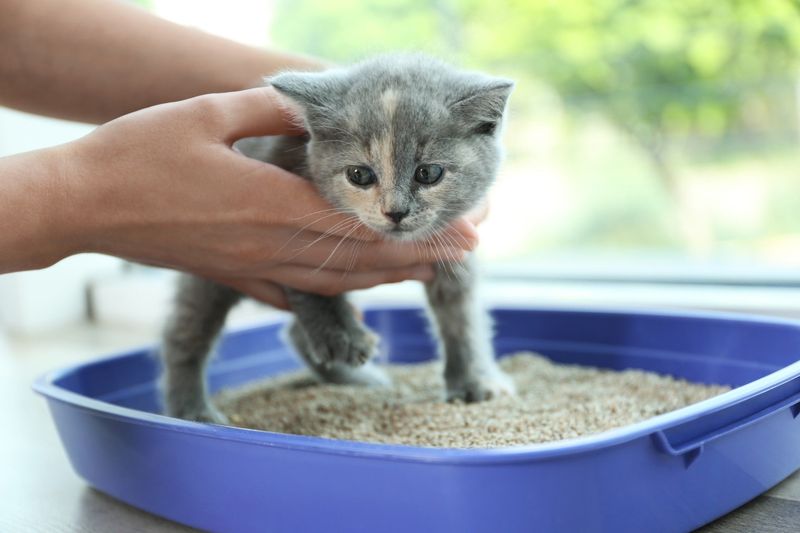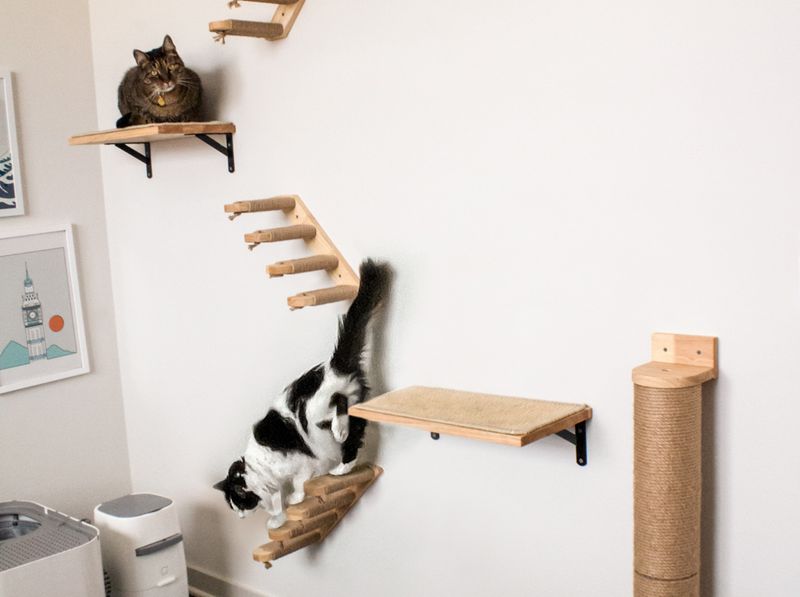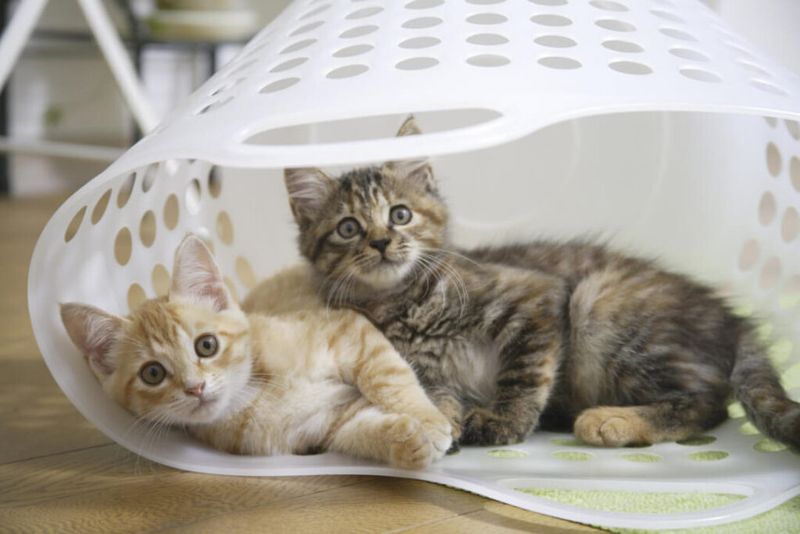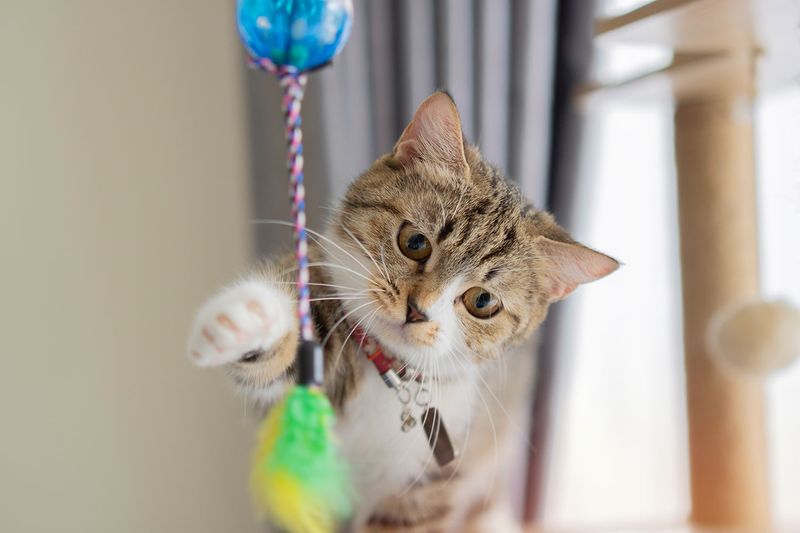📖 Table of Content:
- 1. Create a Safe Space
- 2. Schedule a Vet Visit
- 3. Feed Quality Kitten Food
- 4. Master Litter Box Training
- 5. Provide Plenty of Playtime
- 6. Start Grooming Early
- 7. Socialize with People and Pets
- 8. Establish a Scratching Routine
- 9. Create Vertical Space
- 10. Establish a Daily Routine
- 11. Learn Body Language Basics
- 12. Handle With Care
- 13. Manage Alone Time Gradually
- 14. Train Basic Commands
- 15. Provide Mental Stimulation
- 16. Build a Lifetime Bond
Bringing home a new kitten is an exciting adventure filled with purrs, playful pounces, and adorable antics. These tiny furballs need proper care and attention to grow into healthy, well-adjusted cats. Whether you’re a first-time cat parent or adding to your feline family, these essential tips will help you create the perfect environment for your new kitten to thrive.
1. Create a Safe Space
When bringing a kitten home, give them a dedicated space to settle in. A quiet room with their litter box, food, water, bed, and toys helps them adjust at their own pace without becoming overwhelmed.
Gradually introduce them to the rest of your home as they gain confidence. Remove dangerous items like toxic plants, small objects they might swallow, and secure loose wires they could chew on.
This initial sanctuary helps reduce stress and builds trust between you and your new furry friend. Many new kitten parents underestimate how important this secure beginning is for long-term confidence.
2. Schedule a Vet Visit
Taking your kitten to the vet within the first week is non-negotiable. Your veterinarian will check for parasites, assess overall health, and set up a vaccination schedule tailored to your kitten’s needs.
Regular checkups catch health issues before they become serious problems. Ask about spaying or neutering timeframes, microchipping, and flea prevention during this initial visit.
Finding a cat-friendly vet practice makes these experiences less stressful for your kitten. Some veterinarians even offer special kitten wellness packages that include all necessary initial care at a bundled rate.
3. Feed Quality Kitten Food
Kittens have specific nutritional needs different from adult cats. Choose high-quality kitten food specially formulated with extra protein, calories, and nutrients to support their rapid growth and development.
Free-feeding works well for most kittens under six months, as they need frequent small meals. Always provide fresh water in a clean bowl, placed away from their food to mimic natural drinking preferences.
Avoid milk despite popular belief – most cats are lactose intolerant. Consult your vet about appropriate treats that complement their diet without adding empty calories or causing digestive upset.
4. Master Litter Box Training
Fortunately, litter box training comes naturally to most kittens through instinct learned from their mother. Select an appropriately sized box with low sides for easy access and unscented, clumping litter that’s gentle on sensitive paws.
Place the box in a quiet, accessible location away from food and water. Show your kitten the box location immediately upon bringing them home, gently placing them in it several times during the first day.
Clean the box daily to encourage consistent use – kittens are naturally clean animals and may avoid a dirty box. Having multiple boxes in larger homes helps prevent accidents, especially during the adjustment period.
5. Provide Plenty of Playtime
Active play sessions are crucial for kittens’ physical development and mental stimulation. Dedicate at least 20-30 minutes daily to interactive games with wand toys, feathers, or small balls that satisfy their natural hunting instincts.
Rotate toys regularly to maintain interest and prevent boredom. Puzzle feeders and treat-dispensing toys encourage problem-solving skills while providing entertainment when you’re busy.
Playing before mealtime mimics the natural hunt-then-eat pattern and helps prevent behavior problems like nighttime zoomies. Remember that appropriate play teaches kittens not to use hands or feet as toys, preventing painful play-aggression later.
6. Start Grooming Early
Beginning grooming routines while your kitten is young builds positive associations that last a lifetime. Use a soft brush designed for kittens and start with brief, gentle sessions, rewarding with treats and praise.
Regularly handle their paws, ears, and mouth to prepare them for nail trims, ear cleaning, and tooth brushing. Even long-haired kittens need minimal grooming at first, but establishing the routine prevents resistance later.
Nail trimming deserves special attention – use proper cat clippers and only trim the white tips to avoid the quick. Bath time isn’t usually necessary for cats, but introducing them to water gently can help if baths become needed someday.
7. Socialize with People and Pets
The socialization window for kittens is brief but crucial – between 2-7 weeks is ideal, but continues to matter through 14 weeks. Introduce your kitten to different people, including children (with supervision), various handling styles, and everyday household sounds.
If you have other pets, manage introductions carefully and gradually. Use separate spaces with scent exchange first, then controlled visual contact before allowing supervised physical interaction.
Car rides, carriers, and visitors should become normal parts of life during this formative period. Well-socialized kittens grow into confident adult cats who handle new situations with ease rather than fear or aggression.
8. Establish a Scratching Routine
To keep their claws healthy and mark their territory, kittens naturally scratch. Provide a mix of vertical and horizontal scratching posts with various textures to encourage this important behavior.
Position scratchers near sleeping areas and in social spaces where your kitten spends time. When you catch them scratching furniture, gently redirect to appropriate surfaces and reward with treats and praise.
Avoid punishment which creates fear rather than learning. Consider temporary nail caps as a humane alternative to declawing, which is actually amputation of the last bone in each toe and can cause lifelong pain and behavior problems.
9. Create Vertical Space
As natural climbers, cats gain security by surveying their territory from above. Cat trees, wall shelves, and perches meet this instinctual need while promoting physical activity and boosting confidence, particularly in multi-pet households.
Window perches offer entertainment through bird and squirrel watching. Even in small spaces, vertical options maximize your kitten’s territory without taking up floor space.
Climbing opportunities help shy kittens gain confidence by providing escape routes from overwhelming situations. The investment in quality climbing structures pays dividends in preventing destructive behavior and creating a more enriched environment for your growing kitten.
10. Establish a Daily Routine
Predictability is key for kittens. Establish a consistent daily routine for meals, play, and downtime to help your kitten feel secure and prevent anxiety-related issues.
Morning play sessions help burn energy before you leave for work or school. Evening routines might include interactive play followed by feeding to mimic natural hunting patterns and encourage sleeping through the night.
Stick to regular feeding times rather than free-feeding once your kitten reaches 6 months. Routines help with house training, make future schedule changes less stressful, and create natural opportunities for bonding throughout the day.
11. Learn Body Language Basics
Understanding feline communication prevents misunderstandings and builds trust. A slowly blinking kitten is showing affection – try returning these “cat kisses” to strengthen your bond. Purring usually indicates contentment but can sometimes signal stress.
Flattened ears, dilated pupils, and a twitching tail tip warn that your kitten feels threatened or overstimulated. Respect these signals by providing space rather than forcing interaction.
A raised tail greeting means your kitten is happy to see you. Kneading with front paws (often called “making biscuits”) shows comfort and security, a behavior from nursing that continues into adulthood as a sign of contentment.
12. Handle With Care
To help kittens feel secure, use proper lifting techniques. Make sure to support their entire body, especially their hind legs. Never lift a kitten by the scruff, as this is something only their mother does when they’re very young.
Allow your kitten to approach you on their terms. Sitting quietly on the floor with toys encourages positive interaction without intimidation. Keep handling sessions brief at first, gradually increasing duration as trust builds.
Teach children proper handling through demonstration and supervision. Rewarding calm behavior during handling with treats creates positive associations. Remember that forced cuddling creates fear rather than affection – patience yields a kitten who seeks your company voluntarily.
13. Manage Alone Time Gradually
Kittens need to learn independence gradually to prevent separation anxiety. Begin with brief absences, slowly extending time alone as your kitten adjusts. Leave enrichment toys and comfortable resting spots in multiple locations.
Consider adopting kittens in pairs if your schedule keeps you away for long periods. Siblings or bonded pairs provide companionship, exercise, and social learning for each other when humans aren’t available.
Background noise from a radio can provide comfort during alone time. Avoid making departures and returns overly emotional – keep goodbyes and greetings calm to normalize your comings and goings rather than making them significant events that trigger anxiety.
14. Train Basic Commands
Contrary to popular belief, kittens can learn commands through positive reinforcement. Start with their name and simple cues like “come” by pairing the word with treats and affection. Clicker training works particularly well with food-motivated kittens.
Target training (teaching them to touch a stick with their nose) builds the foundation for more complex behaviors. Keep sessions under five minutes to match their short attention spans.
Practical commands like “up” for permission to jump on furniture or “gentle” for play can prevent problem behaviors. Never punish mistakes – simply redirect and reward success. Consistency among family members using the same cues and rewards ensures faster learning.
15. Provide Mental Stimulation
Mental exercise is as important as physical play for developing kittens. Rotate toys regularly to maintain novelty and interest. Food puzzles and treat-dispensing toys engage natural problem-solving instincts while slowing eating for better digestion.
Window perches with bird feeders visible create entertaining “cat TV.” Training sessions, even just a few minutes daily, provide cognitive challenges that prevent boredom-related behavior problems.
Hide treats around a room for “hunting” games that engage natural foraging behaviors. Consider harness training for supervised outdoor exploration when vaccinations are complete. These enrichment activities prevent destructive behaviors like excessive meowing, furniture scratching, or aggressive play.
16. Build a Lifetime Bond
The foundation of your relationship forms during these early months together. Daily quality time creates connection – even just sitting quietly while your kitten naps nearby builds trust and security.
Respect your kitten’s personality and preferences rather than forcing your expectations. Some kittens are naturally more independent, while others seek constant companionship – neither style is wrong, just different.
Photograph this precious kitten stage – they grow quickly! Consider keeping a simple journal of milestones and funny moments. The investment of patience, consistency and gentle handling during kittenhood creates a confident, well-adjusted adult cat who brings joy for many years to come.
















